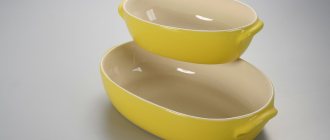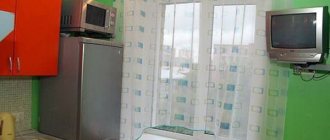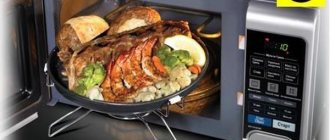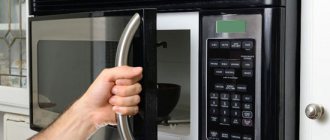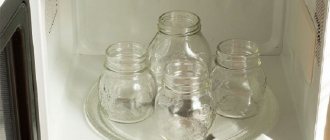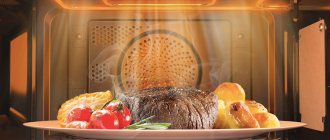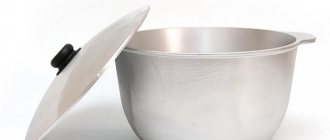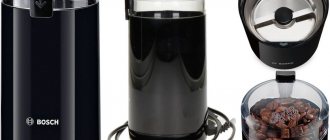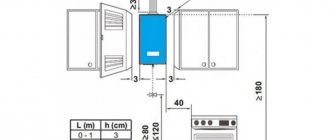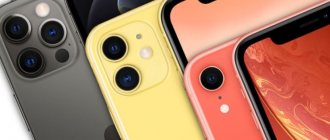Before using a new technique, it is recommended that you first carefully study the instructions. The manufacturer always warns which dishes should not be placed in the microwave. First of all, crystal, melamine and metal are contraindicated for it. If containers made from the listed materials are placed inside, they may deteriorate or damage the device itself. We suggest that you familiarize yourself with the full list of prohibited utensils and products, and also remember the general precautions when cooking in a microwave oven.
How does a microwave oven work?
Surprisingly, the microwave oven is older than many people alive today. It was patented back in 1945 by Percy Spencer, an American engineer. At that time, he worked for the military-industrial company Raytheon and was engaged in the manufacture of radars. One day, absent-mindedly, Spencer placed a sandwich on the switched-on magnetron (an electrical device that generates microwaves) and discovered that it had become hot. The very next year he received a patent for a microwave oven, and in 1947 his invention saw the light of day.
For a long time, microwave ovens caused distrust, were expensive and therefore were not in demand. And even today there are many myths surrounding technology. For example, that microwave radiation allegedly changes the structure of dietary fiber or water, turning them into dangerous carcinogens. In fact, the operating principle of a microwave oven is the dielectric heating of substances containing polar molecules. Microwave energy is not enough to break chemical bonds. Electromagnetic waves cause the movement of molecules, and the resulting friction between them naturally increases the temperature of the substance. In other words, in microwave ovens, normal heating occurs - and nothing more.
Household microwave ovens operate at a frequency of 2450 MHz (within the absorption spectrum of water). The radiation source is a magnetron with a power of 500 W or more. It directs and concentrates high-frequency waves in a metal chamber, where the dishes with food are actually placed for heating or cooking.
Why can't everything be heated in the microwave?
The microwave oven requires special handling and safety precautions. During operation, high-frequency radiation is supplied to the camera, which acts completely differently than the fire that is familiar to many. Microwaves are reflected from the metal, which leads not only to its heating, but also to the appearance of an electric arc (lightning, crackling, discharge). The second taboo for a microwave oven is hermetically sealed containers. Under the influence of electromagnetic waves, moisture evaporates very quickly, which entails an increase in pressure in a confined space and an explosion. Packages, containers with lids, and even foods (eggs and others) can explode.
We recommend: Why is it considered harmful to heat food in the microwave?
List of prohibited materials
It is strictly forbidden to put only 3 types of dishes in the microwave:
- Metal. As already mentioned, metal (brass, iron, copper, cast iron, steel) does not transmit microwaves and causes spark discharges. Using such utensils for heating or cooking in the microwave is extremely dangerous!
- Crystal. There are quite a lot of inclusions of lead, silver and other metals in crystal. In the microwave, the material becomes very hot and shatters.
- Melamine. Melamine dishes are very similar to porcelain, but they are inexpensive and very light. Unfortunately, it melts quickly and, by the way, is unsafe for health. It is absolutely not suitable for use in the microwave.
As usual, any rule has exceptions. You can cook in a shallow metal container if you do not turn on the microwave mode - grill, convection, or a combination of both.
It is prohibited to place not only plates, pots and pans made from the above materials in the microwave. It is important to ensure that no spoon or other cutlery is accidentally left in it.
What not to heat food in a microwave oven
If, then for some kitchen utensils it is the worst enemy. Without worrying about the “compatibility” of new equipment and your favorite saucepans, you can ruin food, set fire to the stove, or cause an explosion. There are some materials that should never be placed in the chamber, and there are exceptions for others. How to distinguish them?
Plastic
When a plastic container is labeled with an approval sticker, it is best to ignore (or check) the manufacturer's permission. According to the law, he is not required to test his products during production.
When heated, plastic releases special toxic substances that easily penetrate food. Warming up your lunch for a long time in a low-quality plastic lunch box will cause it to come out of the oven melted. Heating using cling film has a similar effect: carcinogens from polymer materials get inside the food.
Gold plated plates
The “saucer with the golden edge” can sparkle if you put it in the microwave. The immediate danger is fire. Spare the electrical appliance, yourself and your home. Beautiful plates and dishes with gold patterns are not designed to be exposed to waves.
Why you can’t put gold plating in the microwave
The electrical appliance is made of metal, and there is a mesh on the door - have you noticed? There are no exceptions in any model! The design features prevent microwaves from leaving the housing; the metal serves as protection. A spark, an electric arc, or a fire will appear inside a microwave oven that contains an iron bowl by mistake or for fun.
But there are also specialized dishes created for the needs of microwave oven users. This includes the Aqua Cook Samsung set - the steaming set has a metal cap that protects food from exposure to microwaves.
Combination ovens
If you get an appliance equipped with a grill or heater, there are loopholes. Often a heating element or grill can be used independently, without radiation. Then cook in pots, pans, iron trays, salad bowls - the list goes on, but do not forget to turn off the microwave mode.
Porcelain
Porcelain utensils produced in the post-Soviet space contain lead. Heavy metals were mixed into raw materials for durability, excellent performance and elegance of products. Porcelain cups, glasses, bowls, salad bowls, tureens containing lead are very dangerous for microwaves.
Hardware
“Can I put iron cookware in the microwave?” - you ask. "No!" - experts and manufacturers will answer.
The metal reflects waves that can lead to an explosion - at best, you will throw out the stove, at worst, you can easily get injured. Do not assemble such a “bomb” with your own hands. Iron, aluminum, enameled and other metal utensils cannot be placed in the chamber, because they begin to spark. As with gold plating, this poses a risk of fire.
On a note! Avoid heating paper boxes, foil from fast foods or sushi bars. The best material for heating sandwiches and other similar foods is parchment baking paper.
Crystal
If the crystal is not fake, it contains lead, and expensive crystal contains silver. In faceted products, the wall thickness is not the same, so the heating process will not be uniform. Metal impurities lead to a rapid increase in temperature - your favorite salad bowl or vase bursts. If crystal objects are dear to you, do without experimenting.
How does the tree react?
We don't often use wooden utensils: at most it's a cutting board, a hot tray, or a container for storing cereals. Few people cook in wooden bowls, but there will always be enthusiasts.
Manufacturers (not all) warn against using wooden utensils, otherwise they may overheat and become charred. But you can try using it in short cycles - when heating or preparing quick dishes. The type of food also matters: avoid fatty and sugary foods.
Remember that wood may contain moisture, it is a living material, and the waves of the device do not affect objects, but water molecules. So products made from “fresh” wood are deformed by moisture.
Paper items
There is no prohibition on using disposable paper or cardboard utensils in a microwave oven. But it is not suitable for long-term cooking (especially fatty foods). Packaging containers coated with plastic or wax will definitely “leak”—products that receive the melted coating will deteriorate.
You can use ordinary paper towels for the kitchen, and cover the baking sheets with tracing paper, as when baking in the oven. When baking cupcakes, you can use corrugated paper molds. Avoid recycled paper, which may contain toxins and metals.
Controversial materials
Some utensils may or may not be suitable for use in a microwave oven. Much depends on the manufacturing technology, additional protective properties, and wall thickness. A special point should be made about the presence of paint and metal decorative elements. Even a completely ordinary-looking dye without shine can contain metal in its composition. Such dishes will become very hot or spark in the microwave, but their contents will remain cold. Coffee mugs and plates with patterns often suffer from this problem.
List of “controversial” microwave cookware:
- Ceramic. Ceramics that are not protected by glaze heat up unevenly and crack when exposed to microwaves. It can be used in a microwave oven only when the glaze completely covers the dish, including the bottom, and there are no slightest chips or cracks.
- Clay, earthenware, porcelain. Like ceramics, clay, earthenware and porcelain are susceptible to cracking. Inside they are heterogeneous and full of internal bubbles. The glaze saves the situation, but still, when cooking, such dishes get very hot. When removing a dish from the microwave, you must definitely use oven mitts to avoid getting burned.
- Bamboo dishes. Manufacturers often mark it as not microwave safe. However, many people successfully heat food in it... up to a certain point. The fact is that bamboo perfectly absorbs water, which evaporates too quickly inside the chamber. Even a slightly damp plate can crack if heated for a long time or at high temperatures.
- Ordinary glass. Glass transmits microwaves better than other materials and can be used to heat food in a microwave oven. However, if the walls of the pan are too thin, it may burst. To avoid this, you should place it in the center, away from the walls of the chamber.
- Plastic. Plastic is not afraid of temperature changes; many people love it because in such a container you can heat food directly from the freezer. However, not all containers are suitable for cooking in a microwave oven. Plastic dishes must have the appropriate microwave symbol and be heat-resistant (withstand temperatures of 130–140 degrees).
- Disposable paper tableware, plastic bags. When contacting hot food, such materials begin to release harmful substances - wax, dyes. Using such containers for cooking is unsafe for health. These are options for extreme cases when you need to quickly reheat or defrost food.
- Foil. Contains metals and does not transmit microwaves well. The only possible use is as a substrate.
We recommend: Why do you need mica in the microwave and what to do if it burns?
What kind of dishes can I use?
- Utensils made specifically for microwave ovens are made from tempered heat-resistant glass. You can cook in it as much as you want, anywhere. Even in a regular electric or gas oven.
- The second recommended option is silicone molds. High-quality silicone allows microwaves to pass through and can withstand temperatures from -40 to +240 degrees.
- It is also allowed to use parchment paper and a special sleeve for baking fish and meat for cooking in the microwave.
Is there copper in the microwave?
Many consumers are simply confident that, with the exception of the power cord, there are no other parts in the microwave oven that contain this metal. How then does a household device work? That's right - no way. And, in view of what has been said, the indicated opinion is erroneous. In reality, various wiring and the motor still contain copper, and it is they that ensure the stable and uninterrupted operation of a household device.
Where to look for copper in a microwave oven?
First, you will need to take a screwdriver to disassemble the device. At the first stage, we remove the back panel and door, after which all the insides of the household appliance will appear. There we will see several small transformers (coils), as well as small wiring, and a propeller consisting of stainless blades and a copper coil.
But the main part of the treasured metal is located mainly in the transformer, which in the majority forms the cost of the microwave oven.
Why do you need copper in a microwave?
As mentioned above, the transformer is the main part, without which the stove simply will not work. In addition to the above, small parts containing copper are also an integral part, namely wiring and boards that ensure the operation of the timer and the general control panel of the device.
On a note! This metal makes it possible to set the desired heating temperature for food and its duration, as well as apply options (depending on the purchased model).
What foods cannot be put in a microwave oven?
Dishes are not the only taboo for the microwave. Some products cannot be placed in it:
- eggs in shell (explode);
- milk and fermented milk products (heat unevenly, curdle);
- any products in sealed packaging (explode);
- ready-made infant formula (heats unevenly, curdles)
- mushrooms and chicken (they spoil quickly; when frozen, heating is uneven);
- frozen berries (nutrients disappear);
- honey (at a temperature of 40 degrees the product loses its benefits).
General precautions
In addition to the list of prohibited utensils and products for the microwave oven, it is important to remember several important rules for its use.
What not to do?
- Place the dishes close to the walls of the chamber.
- Cook or reheat in a container that sparks. The appliance must be turned off immediately and the plate removed.
- Allow temperature changes - put dishes from the refrigerator into the oven, remove a hot dish onto a cold or wet surface. The exceptions are plastic and silicone.
- Cook or reheat food in a hermetically sealed container. A hole should be provided for steam to escape.
The microwave makes life easier and faster, but it is important to use it correctly. Initially, you need to choose suitable dishes for it. It is not necessary to buy a new one - a special one. Select old glass plates with thick walls, white ceramics without patterns, heat-resistant plastic, silicone molds, parchment - and you can easily and safely prepare many delicious dishes.
The right dishes for the microwave
How to choose dishes for the microwave and not make a mistake? Any containers made of heat-resistant glass and heat-resistant plastic are suitable for microwaves. Ordinary ceramic cups and plates can also be used to heat food, but it is still not recommended to cook in them: excessive heating may cause the walls to burst and fragments will fall into the food. For the convenience of users, there are special disposable forms made of thick pressed paper. Plastic containers intended for storing food usually have markings on them that indicate whether the container can be heated in an oven.
Dishes used in the oven must be clean, free of greasy splashes or deposits. When heated, dirt can smoke, which will certainly spoil the quality of food. You also need to carefully monitor the cleanliness of the internal walls of the microwave in order to maximize its service life. Regularly remove plaque from the internal walls, having first disconnected the device from the power supply. To soften the hardest stains, pour water into a large container, add 20 grams of baking soda and 20 ml of table vinegar. Place the liquid inside the microwave and boil for 3-5 minutes. After this, you can proceed directly to cleaning.
Now you know whether you can put iron cookware in the microwave. By abandoning metal in favor of ceramics, porcelain and plastic, you will extend the life of the microwave.
